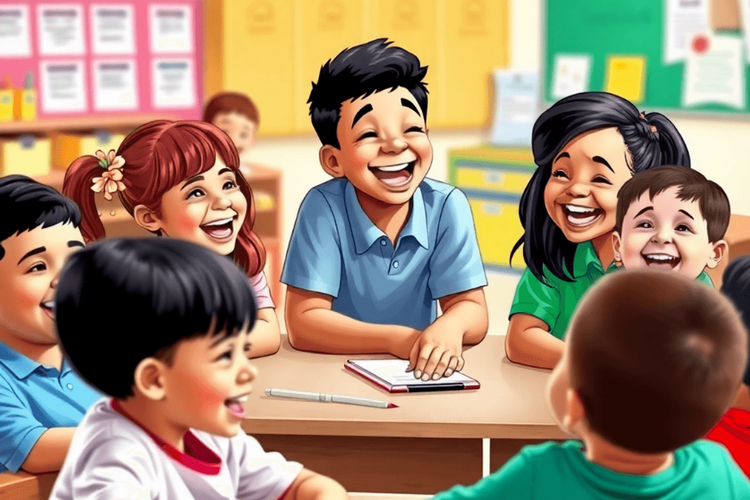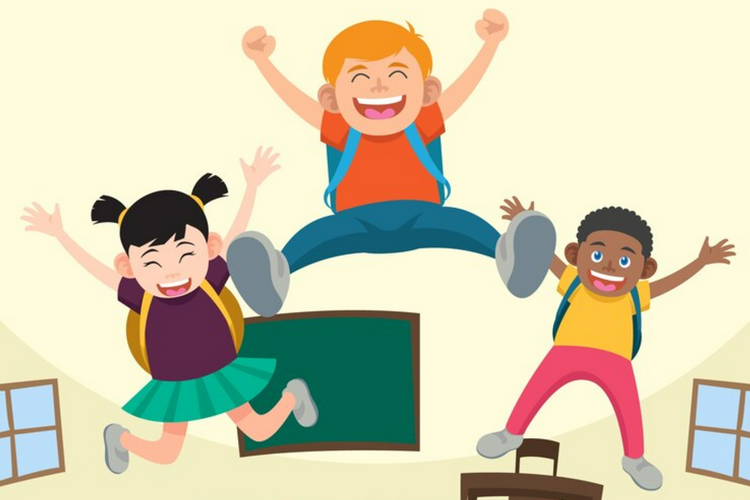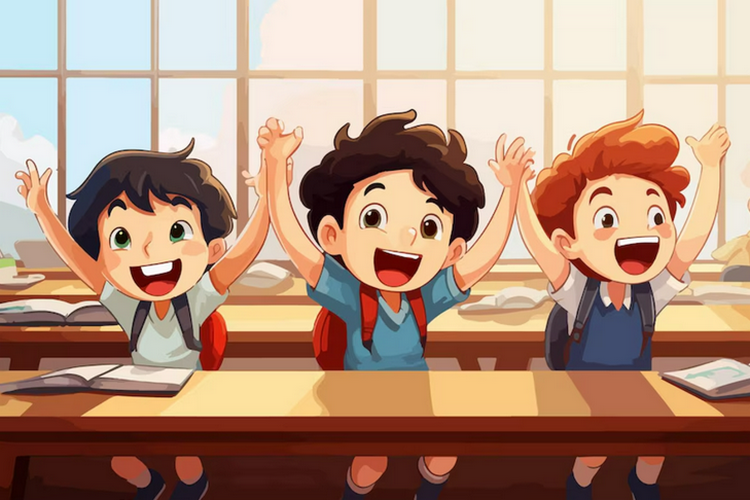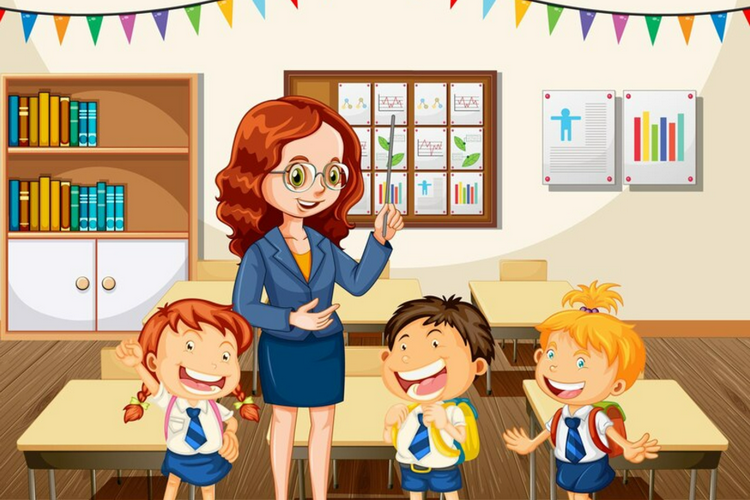


Laughter is often called a universal language. It’s an instinctive reaction to funny jokes that shows happiness and enjoyment. Humor refers to the quality of being funny or entertaining. Together, laughter and humor form a powerful combination known as the science of laughter, which is essential for improving learning, especially for elementary students.
The connection between humor and learning has been extensively studied. Jokes and playful interactions can greatly boost mental involvement and memory retention. When students find something funny, they become more attentive, making it easier for them to understand and remember information. This link is why the subject of laughter in education is so significant for teachers and parents.
For teachers who want to create an interesting classroom atmosphere, it’s crucial to know how to use humor effectively. Parents can also benefit from realizing that fun and laughter at home can enhance learning beyond school hours. At 4Kids, we offer resources and insights into effective educational strategies like these, ensuring every child’s learning journey is both enriching and enjoyable.
In this article, we’ll delve into the science of laughter. Our goal is to help educators incorporate humor into their teaching methods while equipping parents with tools to enhance their child’s educational experience.

Laughter has a profound impact on our brain chemistry. When we laugh, our brain releases dopamine, a neurotransmitter that plays a crucial role in how we feel pleasure. This release not only elevates mood but also enhances our ability to learn and retain information.
1. Dopamine’s Role
This “feel-good” chemical is intrinsic to emotional well-being, acting as a natural reward system. It motivates us to engage with content, making learning an enjoyable experience rather than a chore.
2. Emotional Health and Classroom Dynamics
A classroom filled with laughter can transform the educational atmosphere. Students who are emotionally healthy are more likely to participate actively and collaborate effectively. Humor fosters an environment where students feel safe and valued, paving the way for open communication and shared joy.
3. Positive Emotions and Cognitive Function
There is a strong link between positive emotions, such as those elicited by humor, and enhanced cognitive functions. These include improved memory, attention span, and problem-solving skills. The connection lies in the fact that when students are happy, their brains are more primed for learning.
By understanding these psychological benefits, educators can leverage humor as a powerful tool to enrich educational experiences. Explore more ways to incorporate humor into learning by visiting our best funny jokes for kids section on 4Kids.com.
Humor is not just a tool for entertainment; it plays a significant role in enhancing learning outcomes by improving memory retention, boosting engagement, and elevating academic performance. Several studies have shown that humor can lead to improved attention and memory among elementary students. When students are engaged through humor, they are more likely to focus on the content being taught, which in turn aids in better retention of information.
Research indicates that when humor is incorporated into lessons, it activates the brain’s reward system. This activation leads to the release of dopamine, a neurotransmitter associated with pleasure and motivation. The presence of dopamine enhances cognitive processes such as attention, which is crucial for learning. Teachers who use humor effectively can capture students’ interest and motivate them to participate actively in their education.
There’s also a positive correlation between humor and higher comprehension scores. When elementary students find the material engaging due to its humorous presentation, they tend to understand it better. This understanding translates into better performance on comprehension tests and assignments. For instance, a study conducted in various elementary schools found that classes with teachers who used humorous anecdotes related to the lesson scored significantly higher on comprehension tests than those who did not.
Examples of successful educational outcomes abound where educators have embraced humor as part of their teaching strategy. In one case, a teacher used funny stories related to historical events, making history lessons not only memorable but enjoyable for elementary students. This approach resulted in higher test scores and increased enthusiasm for learning the subject.
At 4Kids.com, we recognize the importance of innovative teaching methods such as humor in education. Our platform offers resources and events designed to support educators and parents in creating engaging learning environments for children.
Explore opportunities like our Summer Camps or check out some Funny Summer Jokes for Kids to bring a smile to your child’s face while learning!

Humor plays a crucial role in fostering a positive classroom atmosphere that promotes student motivation and active participation. When teachers incorporate humor into their lessons, it helps build stronger rapport with students, creating a more relaxed and open learning environment. This connection encourages students to engage more freely, ask questions, and express themselves without fear of judgment.
To successfully integrate humor without detracting from the educational content, educators can:
Creating a supportive environment is essential for catering to diverse learning styles. Humor can bridge gaps between different elementary students backgrounds and abilities by offering alternative ways to understand complex concepts. This inclusive approach not only makes lessons more enjoyable but also enhances comprehension for all students.
The importance of strategically using humor as a tool for engagement is emphasized in The Science of Laughter: How Jokes Enhance Learning in Elementary Students. A well-timed joke or humorous story can be transformative in keeping students motivated and eager to learn.
Explore our events for opportunities that integrate humor and learning, where both educators and parents can find inspiration to make education more engaging and effective.

Effective humor in education hinges on relevance, audience appropriateness, and maintaining a balance in teaching. When integrating humor, it’s essential to ensure that the jokes and anecdotes complement the subject matter and resonate with the student age group. For younger students, playful and simple jokes often work best, while older students might appreciate more sophisticated wit.
Key guidelines for educators include:
Despite its benefits, humor poses certain risks if misapplied:
By adhering to these principles, educators can harness the power of laughter to create a vibrant learning atmosphere while ensuring that educational goals remain at the forefront. To explore more ways of incorporating fun into learning, check out our best funny jokes for kids.
Educators are encouraged to embrace laughter as a learning tool in the classroom. The positive effects of humor on cognitive development and emotional well-being are undeniable, as shown by The Science of Laughter: How Jokes Enhance Learning in Elementary Students. By incorporating humor into teaching methods, educators can create an engaging and supportive environment that promotes learning. Looking ahead, integrating humor should be seen as an important strategy in shaping effective learning experiences. Explore creative ways to infuse humor into educational practices to unlock the full potential of every student.
What is the relationship between laughter and learning?
Laughter and humor play a significant role in enhancing learning by triggering positive emotions that can improve attention, memory retention, and overall academic performance. This connection highlights the importance of integrating humor into educational settings.
How does laughter affect emotional well-being in the classroom?
Laughter triggers the release of dopamine, which positively impacts brain chemistry and emotional health. This creates a more dynamic classroom environment, fostering better relationships between students and teachers and enhancing cognitive function.
What evidence supports the use of humor in educational outcomes?
Studies have shown that incorporating humor into teaching methods leads to improved attention spans, higher memory retention rates, and better comprehension scores among students. These findings suggest that humor can be a powerful tool for educators.
How can teachers effectively use humor in the classroom?
Teachers can build rapport with students by using appropriate humor that aligns with the subject matter. Strategies include sharing relevant jokes or funny anecdotes while maintaining focus on educational content, creating an engaging atmosphere that supports diverse learning styles.
What are some guidelines for using humor appropriately in education?
When using humor in education, it’s crucial to ensure relevance to the subject matter and appropriateness for the student age group. Teachers should balance humor with instructional goals to avoid distractions or misunderstandings that could arise from excessive or inappropriate jokes.
What implications does laughter have for future educational practices?
Laughter can serve as a valuable learning tool, encouraging educators to explore humorous methods in their classrooms. By recognizing the benefits of laughter, educators can foster more engaging and effective learning environments for students.
Categories :
Tags :
We believe in building & supporting the community and that finding the resources and things to do for your kids should be easy. 4kids.com is a FREE online resource guide for families with kids in a city near you.
View All PostsNotifications